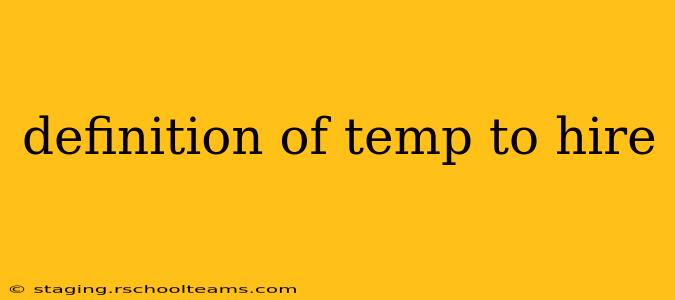Temp-to-hire, also known as temporary-to-permanent employment, is a staffing arrangement where a company hires a temporary employee with the potential for converting that position into a full-time, permanent role. It's a strategic approach used by businesses to assess a candidate's skills and fit within the company culture before committing to a long-term employment contract. This arrangement benefits both the employer and the employee, offering flexibility and a trial period for a mutually beneficial outcome.
This guide will delve into the specifics of temp-to-hire employment, clarifying its definition and exploring the advantages and disadvantages for both employers and employees.
What are the benefits of temp-to-hire for employers?
For employers, the temp-to-hire model offers several key advantages:
- Reduced Hiring Risks: It allows companies to thoroughly evaluate a candidate's performance, work ethic, and cultural fit before committing to a permanent position. This significantly reduces the risk of a costly and time-consuming bad hire.
- Flexibility and Scalability: Temp-to-hire allows businesses to easily adjust their workforce to meet fluctuating demands. They can quickly bring on temporary employees during peak seasons or periods of high workload and then transition suitable candidates to permanent roles if needed.
- Cost-Effectiveness (initially): Initially, the employer pays only the temporary agency's fees, which are typically less than the total cost of employing a full-time employee (including benefits and payroll taxes).
- Access to a Wider Talent Pool: Temporary staffing agencies often have access to a larger pool of candidates than a company might reach through traditional recruitment methods. This expands the employer's options for finding suitable individuals.
- Specialized Skills: Temp agencies often specialize in specific industries or skill sets, making it easier for employers to find candidates with niche expertise.
What are the benefits of temp-to-hire for employees?
From the employee's perspective, a temp-to-hire arrangement also presents several benefits:
- Gaining Valuable Experience: It provides an opportunity to gain experience in a new company and industry, building a strong resume and enhancing professional skills.
- "Trial Run" for the Company: The temporary period allows the employee to assess the company culture, management style, and overall work environment before committing to a long-term role. They can determine if it's a good fit for their career goals.
- Increased Chances of Permanent Employment: Successful temporary employees often have a significant advantage in being offered a permanent position, assuming a mutual fit is established.
- Improved Negotiating Position: After demonstrating their value during the temporary period, employees can often negotiate better salary and benefits packages when offered a permanent role.
- Immediate Income: It provides immediate income while searching for a more permanent position, easing financial pressures.
What is the difference between temp and temp-to-hire?
The key difference lies in the intention and expectation of the arrangement. A standard temporary position is typically for a defined period, with no guarantee of permanent employment. Temp-to-hire, however, implies the possibility of conversion to a permanent position, contingent on the employee's performance and the company's needs. The expectation is clearly communicated upfront in a temp-to-hire arrangement.
How long is a temp-to-hire assignment typically?
The duration of a temp-to-hire assignment varies significantly depending on the role, company, and employee performance. It can range from a few weeks to several months. Often, the initial temporary contract specifies a review period, after which the possibility of permanent employment will be discussed.
What are the drawbacks of temp-to-hire for employers and employees?
While advantageous, temp-to-hire also presents some drawbacks:
For Employers:
- Administrative Overhead: Managing temporary employees, even through an agency, still requires administrative effort.
- Potential for Turnover: If the temp employee doesn't convert to a permanent role, the employer must restart the recruitment process.
- Agency Fees: Paying agency fees, while initially lower than the cost of a full-time employee, can add up over time if the temporary assignment extends.
For Employees:
- Uncertainty of Permanent Employment: There's no guarantee of a permanent position even if the employee performs exceptionally well.
- Lower Pay Rate (Initially): Temporary positions often come with a lower hourly or salary rate than permanent roles.
- Lack of Benefits: Temporary employees typically don't receive the same benefits package as permanent employees.
Conclusion
Temp-to-hire offers a flexible and strategic approach to recruitment, benefiting both employers and employees. Understanding the nuances of this employment model is crucial for navigating the process successfully. Careful consideration of the advantages and disadvantages, as outlined above, can help both parties make informed decisions that align with their respective needs and goals.
